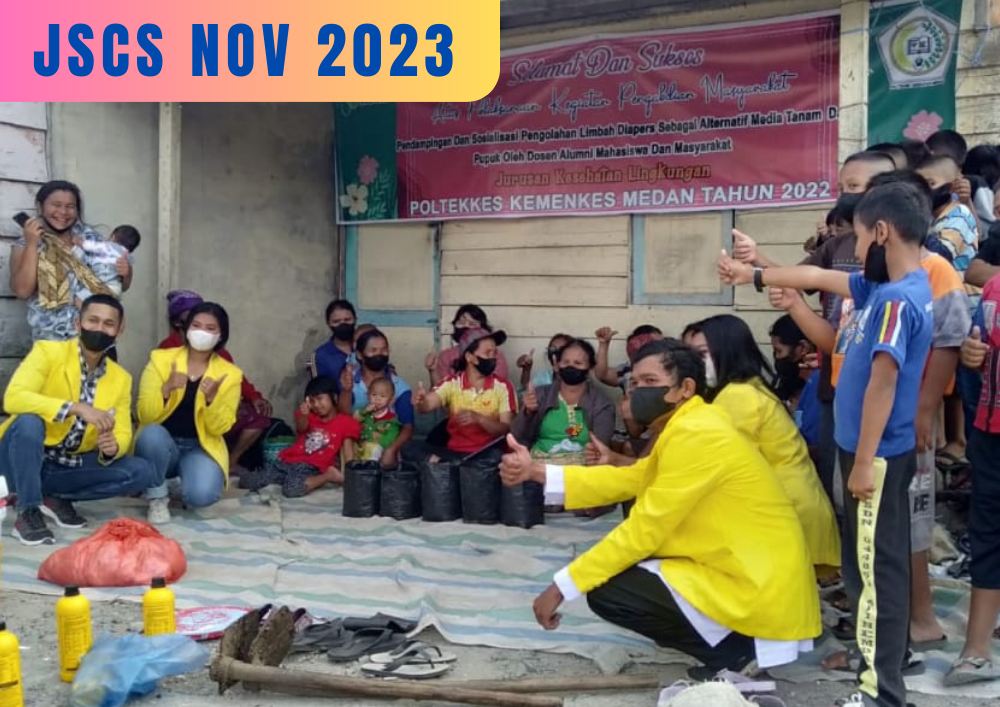Pendampingan Dan Sosialisasi Pengolahan Limbah Diapers Sebagai Alternatif Media Tanam Dan Pupuk
- Authors
-
-
Susanti Br Perangin-angin
Politeknik Kesehatan Kemenkes Medan -
Erba Kalto Manik
Politeknik Kesehatan Kemenkes Medan -
Nelson Tanjung
Politeknik Kesehatan Kemenkes Medan
-
- Keywords:
- Diaper waste, planting media and fertilizer
- Abstract
-
AbstractIndonesia is the third largest consumer of disposable baby diapers after India and China. Research conducted on babies aged 0-2 years, this research was conducted by Ritcer in 2005. The use of disposable diapers in Indonesia can reach around 12 million disposable diapers every year. Based on a study by Sigma Research (2017), it was found that the highest initial use of diapers in babies aged two years was between the ages of 0-3 months, namely in babies aged < 1 month it was 16.1%, and the highest was obtained when babies were aged 1 - 3 month amounted to 69.6%. Disposable baby diapers are the most popular among mothers with a percentage of 95.2%. This type of diapers and pampers waste can actually be categorized as B3 waste because of its infectious nature, but in fact not many people in the field have paid attention to this problem or even prepared a disposal and management system for the general public, especially in rural areas, so it becomes a big problem if a security system is not implemented. waste that is infectious in nature. The aim of this community service activity is to understand the sources & negative impacts of diaper waste, know how to use diaper waste as a planting medium and fertilizer, know the tools and materials for making planting media and fertilizer from diaper waste, know the steps for making planting media and fertilizer from diaper waste and the practice of making planting media and fertilizer from diaper waste independently. The method of community service activities is entrepreneurship training for the community to process diaper waste into alternative planting media and fertilizer so that plants, both flowers and vegetables, grow effectively. From learning about the experiences of friends who are observers of waste and the environment in the field, there is an enlightenment and some of the experiences of someone who has applied them in the field of waste problems and who has dealt with the pampers waste problem can be imitated and hopefully it will be useful.
- References
-
Badan Pusat Statistik. 2010. Laju Pertumbuhan Penduduk. Dikutip dari: http://www.bps.go.id. Di akses pada tanggal 25 April 2018.
BPS, BKKBN, Kemenkes, dan ICF Internasional. 2016, Survey Demografi Kesehatan Indonesia 2016. Jakarta : BPS, BKKBN Kemenkes dan ICF Internasional
Colón, J., Mestre-Montserrat, M., PuigVentosa, I., dan Sánchez, A. 2013. Performance of compostable baby used diapers in the composting process with the organic fraction of municipal solid waste. Waste management, 33(5), 1097-1103.
Cowd, M.A. 1991. Kimia Polimer. Penerbit ITB, Bandung
Dey, S., Kenneally, D., Odio, M., dan Hatzopoulos, I. 2016. Modern diaper performance: construction, materials, and safety review. International Journal of Dermatology, 55(S1), 18- 20
Michael J. D. dan A. Schester. 2002. Exposure Assasement to Dioxin From Use Tampon and Diapers. Enviromental Health Perspectives. Volume 110 Number 1 Januari 2002 23-28. Page 2
Kementrian Kesehatan RI. (2017). Pusat Data dan Informasi Kesehatan. Diakses dari http://depkes..go.id/pusatdatainformasi/2017
UU Nomor 18 Tahun 2008 Pengelolaan Sampah Perkotaan.
Wibisono, A. F., & Dewi, P. (2014). Sosialisasi bahaya membuang sampah sembarangan dan menentukan lokasi TPA di dusun deles desa jagonayan kecamatan ngablak. Jurnal Inovasi dan Kewirausahaan,3(1): 2089-308
- Cover Image
-

- Downloads
- Published
- 2023-11-30
- Section
- Articles
- License
-
Copyright (c) 2023 Susanti Br Perangin-angin, Erba Kalto Manik, Nelson Tanjung

This work is licensed under a Creative Commons Attribution-ShareAlike 4.0 International License.
How to Cite
Similar Articles
- Mufarrihul Hazin, Nunuk Hariyati, Amrozi Khamidi, Aditya Chandra Setiawan, Penguatan Implementasi Kurikulum Merdeka Melalui Pelatihan KOSP di Sekolah Indonesia Kuala Lumpur Malaysia , Journal of Smart Community Service: Vol. 1 No. 2 (2023): JSCS NOV 2023
- Muhamad Hanif Fuadi, Frista Fitriany Ramadhanita, Peran Penyiaran Islam dalam Meningkatkan Kesadaran Kesehatan Mental Remaja , Journal of Smart Community Service: Vol. 2 No. 1 (2024): JSCS MAY 2024
- Aisyah, Isabella Hasiana, Pelatihan Orang Tua dalam Meningkatkan Kemandirian Anak Usia Dini Melalui Aktivitas Harian di Rumah , Journal of Smart Community Service: Vol. 2 No. 2 (2024): JSCS NOV 2024
- Mufarrihul Hazin, Muhammad Turhan Yani, Mohamad Syahidul Haq, Pengembangan Digitalisasi Desa dalam Mewujudkan Transformasi Smart Village di Desa Banjarsari Kabupaten Jombang , Journal of Smart Community Service: Vol. 3 No. 1 (2025): JSCS MAY 2025
You may also start an advanced similarity search for this article.







